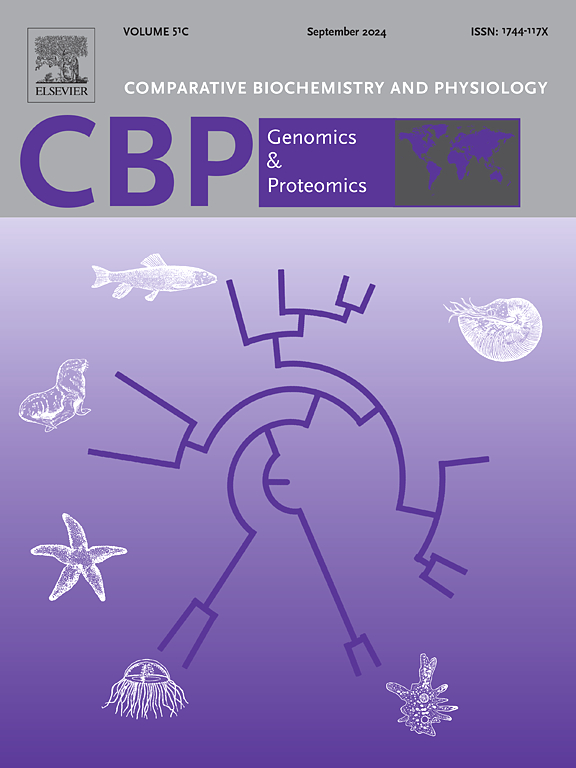暴露于环境污染物的斑马鱼眼毒性的基因组学分析
IF 2.2
2区 生物学
Q4 BIOCHEMISTRY & MOLECULAR BIOLOGY
Comparative Biochemistry and Physiology D-Genomics & Proteomics
Pub Date : 2025-05-27
DOI:10.1016/j.cbd.2025.101544
引用次数: 0
摘要
环境污染物对水生生态系统构成了日益严重的威胁,对包括斑马鱼在内的水生生物的视觉系统的影响尤为显著。斑马鱼(Danio rerio)由于其遗传和生理上与人类的相似性,越来越多地用于毒理学研究,使其成为研究环境毒素影响的理想模型。在接触有毒物质的斑马鱼中,最常观察和研究的眼部畸形是小眼症、独眼症和结肠瘤,所有这些都涉及眼睛的发育异常。我们对500多篇科学文章进行了全面的回顾,以确定与这些眼部缺陷有关的基因和分子途径。本综述的主要重点是探讨单个眼部畸形如何受到多个基因的影响,以及这些基因如何在复杂的分子网络中相互作用。通过详细的网络分析,我们确定了3个关键的“枢纽基因”aldh1a3、vsx2和stra6在这3种眼部畸形中都起着核心作用。这些中心基因包括那些表现出过表达、下调的基因,以及那些受敲除、敲低和突变影响的基因。此外,我们还努力将不同眼部畸形的基因网络联系起来,以确定可能在各种情况下共享的共同遗传因素。令人惊讶的是,相同的中心基因被确定为毒性诱导的眼部表型的关键参与者。这种方法可以帮助发现遗传途径,这不仅对理解特定的眼部畸形至关重要,而且还有助于深入了解环境污染物破坏眼部发育的更广泛机制。这篇综述强调了影响眼睛畸形的遗传因素相互关联的本质,并强调了在毒物暴露的背景下,这些基因如何促进眼睛健康的需要更综合的观点。本文章由计算机程序翻译,如有差异,请以英文原文为准。

Genomics profile of ocular toxicity in zebrafish exposed to environmental contaminants
Environmental contaminants present a significant and growing threat to aquatic ecosystems, with a particularly notable impact on the visual systems of aquatic organisms, including zebrafish. Zebrafish (Danio rerio) are increasingly used in toxicological research because of their genetic and physiological similarities to humans, making them an ideal model for studying the effects of environmental toxins. Among the most frequently observed and studied ocular malformations in zebrafish exposed to toxicants are microphthalmia, cyclopia, and coloboma, all of which involve developmental abnormalities of the eyes. A comprehensive review of over 500 scientific articles was conducted to identify the genes and molecular pathways implicated in these ocular defects. The main focus of this review is to explore how a single ocular malformation can be influenced by multiple genes and how these genes interact within complex molecular networks. Through detailed network analysis of microphthalmia, coloboma and cyclopia, we pinpointed 3 key “hub genes” aldh1a3, vsx2, and stra6 which play central roles in all the three ocular malformations. These hub genes include those that exhibit overexpression, downregulation, as well as those affected by knockout, knockdown, and mutations. Furthermore, an effort was made to connect the gene networks underlying different ocular malformations to identify common genetic factors that may be shared across various conditions. Surprisingly the same hub genes identified are the key players in toxicant induced ocular phenotypes. This approach could help uncover genetic pathways that are critical not only for understanding the specific ocular malformations but also for providing insights into the broader mechanisms through which environmental contaminants disrupt ocular development. This review highlights the interconnected nature of genetic factors influencing eye malformations and emphasizes the need for a more integrated view of how these genes contribute to ocular health in the context of toxicant exposure.
求助全文
通过发布文献求助,成功后即可免费获取论文全文。
去求助
来源期刊
CiteScore
5.10
自引率
3.30%
发文量
69
审稿时长
33 days
期刊介绍:
Comparative Biochemistry & Physiology (CBP) publishes papers in comparative, environmental and evolutionary physiology.
Part D: Genomics and Proteomics (CBPD), focuses on “omics” approaches to physiology, including comparative and functional genomics, metagenomics, transcriptomics, proteomics, metabolomics, and lipidomics. Most studies employ “omics” and/or system biology to test specific hypotheses about molecular and biochemical mechanisms underlying physiological responses to the environment. We encourage papers that address fundamental questions in comparative physiology and biochemistry rather than studies with a focus that is purely technical, methodological or descriptive in nature.

 求助内容:
求助内容: 应助结果提醒方式:
应助结果提醒方式:


